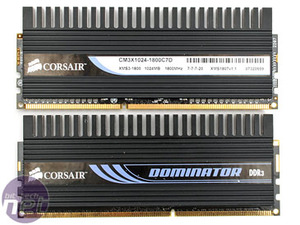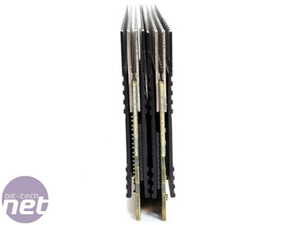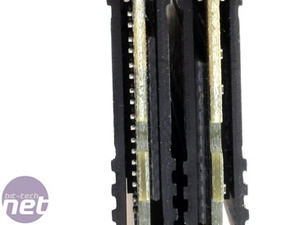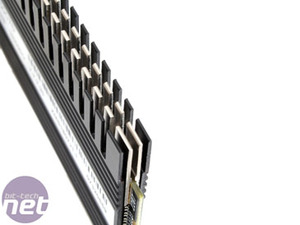
Introduction
We've seen some Kingston and OCZ DDR3 before, but what if we want something even faster? Way outside the stratosphere of the official JEDEC rating of 1,600MHz, we have Corsair making Dominator modules at 1,800MHz and some Super Talent at 1,866MHz. That's over one Gigahertz faster than current DDR2 800MHz.There is absolutely no doubt that these are blazing fast DIMMs using cutting edge technology - 1,800MHz equates to PC3-14400, while 1,866MHz is PC3-14900. However, the speed does come with a price and it's not even worth considering these absolutely premium modules unless you're the type of person who will buy the latest and fastest kit as soon as it arrives, regardless of cost. It does provide some future-proofing to a certain extent, because 1,800+MHz will still be faster than any motherboard can officially handle for quite a while yet - even the X48 chipset due out in January will only increase the official memory capability to 1,600MHz.
With that in mind, we also had a bit of trouble getting these modules to run at rated speeds - none of the Intel P35 boards we have could reach 1,800MHz. The closest we could get was on the Asus Blitz Extreme, which gave up at a blazingly fast 1,760MHz. It wasn't until we received the Intel X38 boards with that we could get the most out of them.
Thankfully, Corsair has provided a guide online in order to try to help users setup their systems in the correct way.
Of course, DDR3 motherboard manufacturers are tailoring their boards BIOS to use these kind of DIMMs - modules that use the famous Micron D9 ICs. Asus has confirmed to us that all of it's X38 DDR3 boards are "tweaked" for them, and MSI has confirmed its P35 Diamond and X38 DDR3 boards are as well.
Typically a super-overclock or high 3DMark score still exerts itself as a great marketing tool, even if you can't practically run a PC on Liquid Nitrogen and 3DMark e-peen says nothing about how it plays real games. 1,066MHz and 1,333MHz DIMMs often use much cheaper Elpida or Quimonda chips and we found the Elpida has very little overhead. It's only when you want something faster that Micron D9s are the preferred choice for more capable DDR3.
There has also been some confusion between Z9 and D9 micron chips - the Z9s are engineering sample chips, whereas D9s are mass production. The "187E" (1.875ns, E=lower latency) D9s are actually rated as 1,066MHz CL-7 at 1.5V - however, these are massively overclockable as both Corsair and Super Talent (among others) are able to overclock and warranty them for a 70 percent core speed increase at the same CAS latency for just 0.5V more.
With all that in mind, let's take a look at the offerings today - the Corsair TWIN3X2048-1800C7DF G (E-I-E-I-OOOO) and the SuperTalent W1866UX2G8.
Corsair TWIN3X2048-1800C7DF G
Manufacturer: CorsairUK Price (as reviewed): £490
US Price (as reviewed): $629
Corsair TWIN3X2048-1800C7DF G Details:
Kit: 2 x 240-pin DDR3 Single Sided DIMMModule Size: 2GB Dual Channel Kit (2 x 1GB)
Module Code: Corsair TWIN3X2048-1800C7DF G
Rated Speed: 1,800MHz DDR3
Rated Timings: 7-7-7-20 (CAS-tRCD-tRP-tRAS)
Rated Voltage: 2.0V
Memory Chips: Micron D9GTR
XMP?: Not in this model, but the TWIN3X2048-1800C7DFIN G does.
The Corsair Dominator modules naturally feature DHX (Dual-path Head Xchange) heatspreaders in black, anodised aluminium and look as strikingly awesome as they ever did. The modules are single sided DIMMs even though both sides are cooled, and come with an extra three-fan Corsair Airflow module that hooks into the memory slots and sits above, directly cooling them.
The general design hasn't changed much apart from the sticker, but there's not really a need to - the DHX technology works very well and should continue to work within the same thermal envelope. Even though DDR3 is inherently lower voltage at 1.5V, the 33 percent over-voltage from the overclock still means they kick out quite a bit of heat when juiced up and working hard.

MSI MPG Velox 100R Chassis Review
October 14 2021 | 15:04












Want to comment? Please log in.